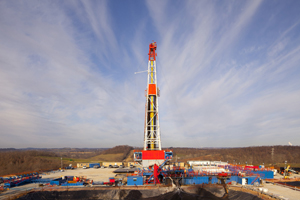The Truth About Natural Gas From Shale
 Natural gas from shale is a game-changer for the United States.
Natural gas from shale is a game-changer for the United States. It offers us greater control over our energy destiny, more jobs and government revenues, energy affordability, and reduced environmental impacts. Unfortunately, there are myths associated with this resource and its method of extraction, which is why I would like to provide a simple explanation of how the process actually works to help demystify it.
Natural gas from dense shale rock formations has become the fastest-growing source of natural gas in the United States and could become a significant new global energy source. According to the Energy Information Administration (EIA), the U.S. has over 2500 trillion cubic feet (Tcf) of recoverable natural gas resources – 33% of which is natural gas from shale. In just one decade, natural gas from shale has grown to around 25% of U.S. gas production and it will nearly double by 2035. This is significant as it will continue to provide the United States with reliable, affordable energy and present economic benefits to regions of the country such as Pennsylvania, Ohio and Michigan.
Although the energy industry has long known about huge gas resources trapped in shale rock formations, it is over the past decade that energy companies have combined two established technologies—hydraulic fracturing and horizontal drilling—to successfully unlock this resource.
Understandably, this natural gas boom has raised some questions and concerns about how this resource is developed, including questions about the process of hydraulic fracturing and the affects, if any, on the water table. While there is much debate and rhetoric surrounding this resource, often times a simple explanation of the process is left out of the discussion. In an effort to help raise awareness of how natural gas from shale is extracted, here is a brief explanation:
Once an area prospective for hydrocarbons has been determined, permission to drill is obtained from the landowner, a lease is signed, permits are secured, and environmental impact studies are conducted. Then seismic data is gathered to determine the best location to place the well in the shale that lies deep underground.
Once determined, a well site is constructed. From the well site, we are able to drill multiple wells from a single site to minimize land use. A drilling rig is then used to drill thousands of feet below the earth’s surface. In the Marcellus Basin, wells are typically around 8,000 feet deep – nearly 7,000 feet below the water table. The rig then drills horizontally, roughly 2,000 to 6,000 feet outward into the layer of shale rock. Many companies use several layers of steel casing and cement to form a continuous barrier between the well and the surrounding formations. In our Marcellus Basin wells located in Northeast United States, for example, Chevron uses up to 8 layers of steel casing and cement through the critical shallow section of the well that contains the water table to ensure the resource is extracted safely.
Because the gas is trapped in dense shale rock, we use the process of hydraulic fracturing to allow the gas to be extracted more easily. In hydraulic fracturing, a fluid comprised of more than 99 percent water and sand and less than 1 percent chemical additives is pumped down the well at a high pressure for a short period of time, usually a few hours. This creates a network of cracks in the shale rock that allows trapped natural gas to flow to the well. The sand helps keep the fractures open and gas flowing. This is not a new practice. It has been safely used since the 1940s in more than 1 million wells in the United States. After the shale rock has been fractured, some of the hydraulic fracturing fluid is returned to the surface through the well pipe, treated and either recycled or disposed of in regulator-approved underground water injection wells.
I support the disclosure of the chemicals used in hydraulic fracturing process. FracFocus.org is a joint website project of the Groundwater Protection Council and the Interstate Oil and Gas Compact Commission, which provides an inventory of compounds used by operators, including Chevron, in the hydraulic fracturing process in the U.S.
Once a well is completed, a pipeline is built to take the natural gas to market to be used for electricity generation, home heating and other energy needs. We then work with the landowner to remediate the drill site and restore the land with minimal impact to its original contours.
After the well site has been remediated, the remaining footprint of a producing natural gas well is typically less than one acre. It includes a well head, a gas processing unit and one or two water tanks. Natural gas wells that produce from shale rock are typically expected to have a long production life spanning many years.
As is the case in other areas of our business, our ability to operate depends on public confidence in our operations. This trust can only be earned through open, honest and timely dialogue with surrounding communities and operating at a high standard.
Natural gas from shale can provide the U.S. with reliable, affordable, cleaner and responsibly produced energy - but we must have a supportive policy framework to encourage this development. Doing so will help enhance the country’s energy security, strengthen local and state economies, and fuel job growth.
You can return to the main Market News page, or press the Back button on your browser.

